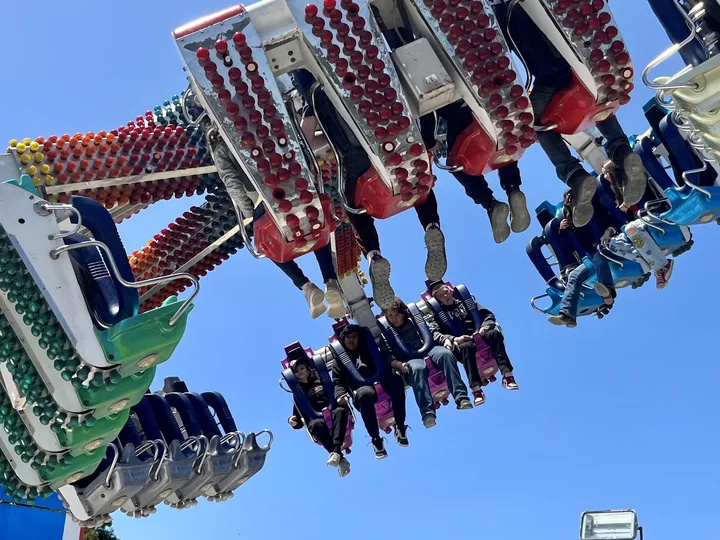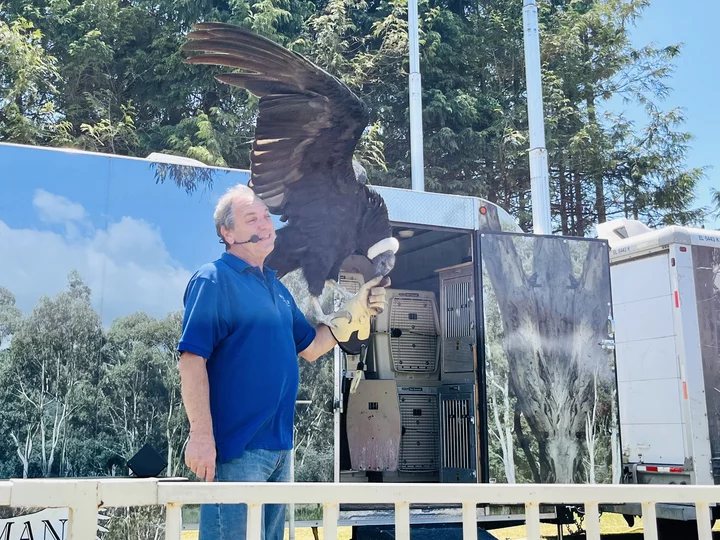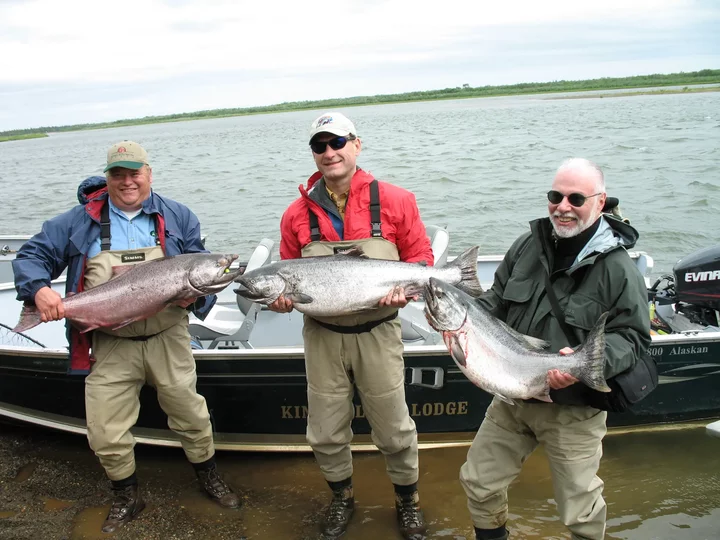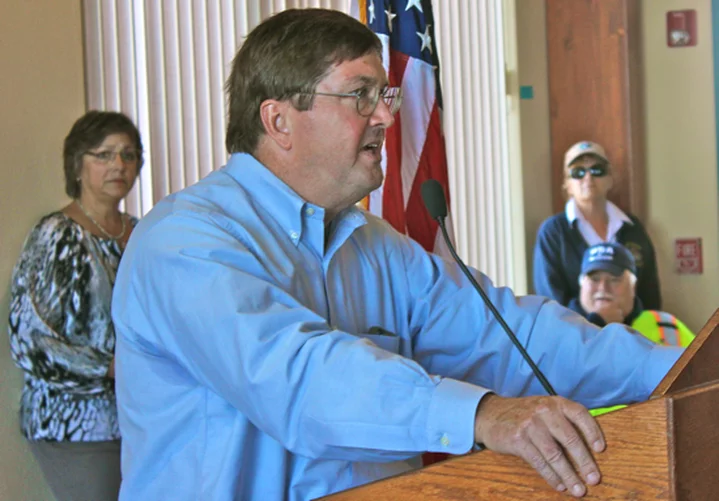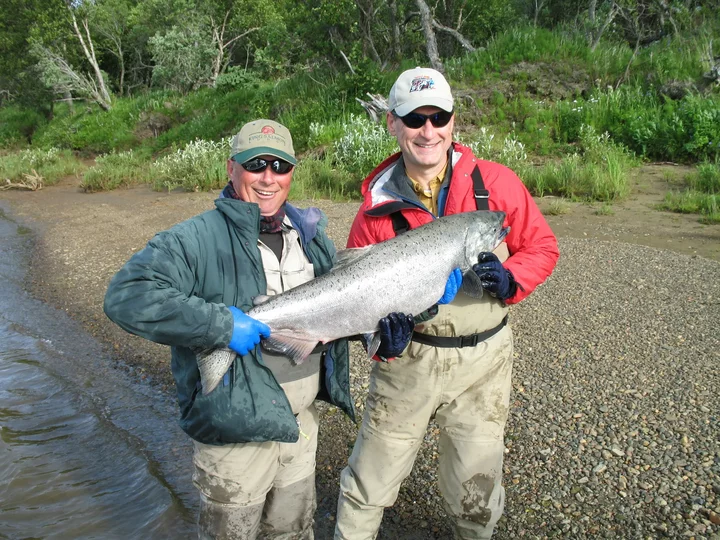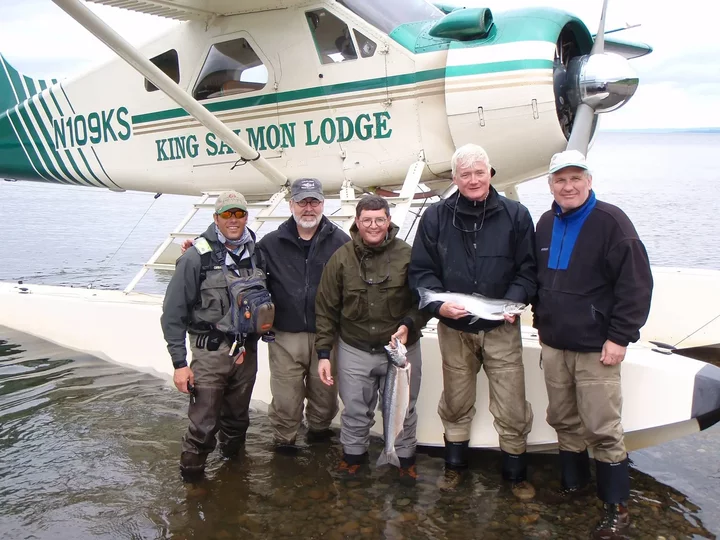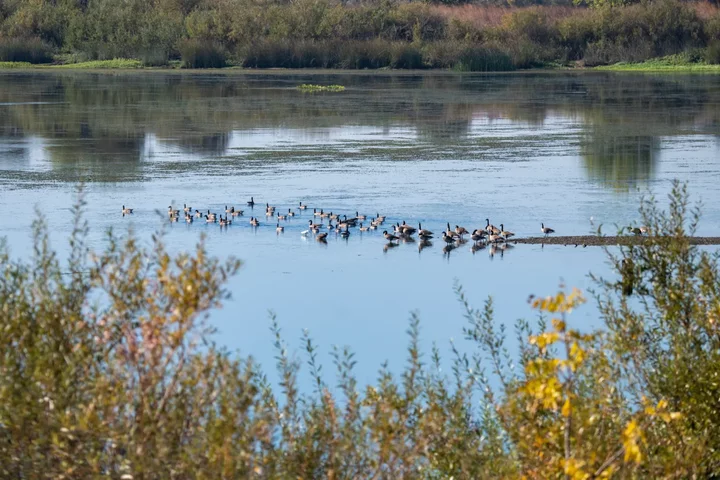YAY! IT’S FAIR TIME: Annual Redwood Acres Fair Kicks Off Today, Raceway’s ‘Hillbilly Boat Race’ Returns This Weekend
Stephanie McGeary / Wednesday, June 21, 2023 @ 4:59 p.m. / Our Culture
Ah..the familiar ferris wheel means summer fun has begun! Redwood Acres Fair on opening day | Photos: Stephanie McGeary, except where noted
Whoohoo! It’s officially the first day of summer, which means that it’s not only the longest day of the year, but also the start of fair season! And the event that always kicks it off – Redwood Acres Fair – was in full swing on its opening day, upholding the annual fair’s 2023 theme: “Summer Starts Here.”
All of the things that you would usually expect were there – greasy funnel cakes, cotton candy and other standard fair fare, lots of livestock and other animals, toy trains, somewhat unsafe-looking rides and, of course, carnival games that are usually almost impossible to win.
Though the fair seemed noticeably less packed on opening day than it was in 2022 (likely because the fair offered free admission on opening day last year), there were still plenty of people out enjoying the splendidly sunny Humboldt day at Redwood Acres. And, hey, less people means shorter lines for the food, tickets and rides!
Of course, things will probably pick up quite a bit over the weekend, especially on Friday evening when stock car racing takes place on the Redwood Acres Raceway (4 to 11 p.m.) The fair also added another special event to this year’s racing, turning Saturday into Motorsports Night. It’ll feature sports car drag racing from the Redwood Sports Car Club and “slideways exhibition” put on by Grassroots Drifting.
The main event of motorsports night will be the Down & Dirty Hillbilly Boat Race – where the race cars drag speed boats behind them and attempt to dislodge the boats of their competitors. According to a press release sent out by Redwood Acres, this will be the first boat race at Redwood Acres since 2016. The races are free with admission to the fair.
“The twist to bringing boat races back will be that the event will be run on the infield of the 3/8-mile track,” the release states. “The main reason boat races have been off the schedule for so long was because of the damage the events did to the racing surface. Boat racing in the dirt should add an all new and exciting challenge to the action that fans will not want to miss out on.”
You can find more information, rules for the boat race and footage of past boat races on the Redwood Acres Raceway Facebook Page. Redwood Acres Fair runs from June 21-25, from noon to midnight. You can find more info on Redwood Acres’ website.
Scroll down for more photos of the fun on opening day!
You could dunk a cop!
“The Birdman” show, featuring a giant Andean condor
the French Quarter in Eureka? these kids seem to enjoy it
Camels and a zebra!
hey! who took my fries?
gotta get a soft serve
BOOKED
Today: 7 felonies, 15 misdemeanors, 0 infractions
JUDGED
Humboldt County Superior Court Calendar: Friday, Oct. 10
CHP REPORTS
Us101 N / Airport Rd Ofr (HM office): Animal Hazard
Us199 / Patrick Creek Rd (HM office): Trfc Collision-No Inj
Patrick Creek Rd / Us199 (HM office): Traffic Hazard
ELSEWHERE
NY Times : How Oakland, Awash in Garbage, Is Trying to Take Out the Trash
Washington Post: China’s demographic crisis means it’s going to run out of workers
Washington Post: Maine high school offers hikes instead of detention. Teachers are seeing results.
Washington Post: A one-click button to protect your privacy is finally real
One Man Dead, Another Suffers Major Injuries After Car Plummets 200 Feet Off Embankment on Scenic Drive Near Trinidad
LoCO Staff / Wednesday, June 21, 2023 @ 2:08 p.m. / Traffic
PREVIOUSLY: SCANNER TRAFFIC INDICATES: Car Over the Side Off Scenic Drive
###
Press release from the California Highway Patrol:
On June 21, 2023, at approximately [10:20 a.m.], CHP Humboldt Communications Center received a report of a vehicle off the roadway, and down a steep embankment, on Scenic Dr., north of Baker Ranch Rd. in Trinidad.
Emergency personnel responded to the scene and located a
20232003 Toyota Camry approximately 200 feet down a steep embankment.Two unidentified males were located inside the vehicle. One party was determined by medical personnel on scene to be deceased. The second party was extricated and transported to the hospital with major injuries.
At this time, it is unknown exactly when this crash may have occurred.
The CHP Humboldt Area office is continuing its investigation and asks anyone who may have additional information to contact the California Highway Patrol at 707-822-5981.
Pounds and Pounds of Meth Found in Fortuna Man’s Possession After Weeks-Long Investigation, Drug Task Force Says
LoCO Staff / Wednesday, June 21, 2023 @ 10:43 a.m. / Crime
Photos: Humboldt County Drug Task Force.
Press release from the Humboldt County Drug Task Force:
On June 20, 2023, Humboldt County Drug Task Force Agents and Officers with the Fortuna Police Department served a multi-location search warrant at a residence located in the 500 block of Francesco Place in Fortuna, a storage unit in the 1000 block of Airport Rd. in Fortuna and on the person of Heriberto Posos Cantu (age 37). After a multi-week investigation, the HCDTF believed Posos Cantu was in possession of large quantities of methamphetamine for the purpose of sales.
HCDTF Agents and FPD Officers responded to Heriberto’s storage unit on Airport Road. Upon their arrival Fortuna Police Officer [Dennis] Stevens and his K9 Partner Cain conducted an open-air sniff inside of the storage unit. K9 Cain alerted on several locations inside of the storage unit indicating that narcotics or firearms were hidden inside. Agents searched the storage unit and located approximately five pounds of methamphetamine, packaging materials and indicia for Posos Cantu.
After Agents were finished searching the storage unit, they responded to Posos Cantu’s residence in the 500 block of Francesco Place. As Agents were approaching Posos Cantu’s residence, a vehicle was seen backing out of the driveway. Agents conducted a traffic stop on the vehicle and three subjects were detained.
Fortuna PD Officer Stevens and his K9 partner Cain conducted an open-air sniff around the vehicle. K9 Cain alerted on the vehicle, indicating that narcotics or firearms were hidden inside. Agents searched the vehicle and located approximately seven pounds of methamphetamine.
It was later determined that Posos Cantu learned that law enforcement was serving a search warrant on his properties. Upon receiving that information, Posos Cantu called a family member and requested that they remove the methamphetamine from the residence prior to law enforcement’s arrival.
Agents searched Posos Cantu’s residence where they located more packaging material, a digital scale and approximately $10,000 in US Currency. As Agents were conducting their investigation at the residence, Posos Cantu arrived on scene. Posos Cantu was placed under arrest without incident.
Posos Cantu was transported to the Humboldt County Correctional Facility where he was booked for the following charge:
- 11378 HS Possession of a controlled substance for the purpose of sales
- Anyone with information related to this investigation or other narcotics related crimes are encouraged to call the Humboldt County Drug Task Force at 707-267-9976.
Justice Samuel Alito Took Luxury Fishing Vacation With GOP Billionaire Who Later Had Cases Before the Court — With Help From Eureka’s Rob Arkley
Justin Elliott, Joshua Kaplan and Alex Mierjeski / Wednesday, June 21, 2023 @ 7:37 a.m. / D.C.
Photo obtained by ProPublica.
###
This story was originally published by ProPublica. ProPublica is a Pulitzer Prize-winning investigative newsroom. Sign up for The Big Story newsletter to receive stories like this one in your inbox.
###
In early July 2008, Samuel Alito stood on a riverbank in a remote corner of Alaska. The Supreme Court justice was on vacation at a luxury fishing lodge that charged more than $1,000 a day, and after catching a king salmon nearly the size of his leg, Alito posed for a picture. To his left, a man stood beaming: Paul Singer, a hedge fund billionaire who has repeatedly asked the Supreme Court to rule in his favor in high-stakes business disputes.
Singer was more than a fellow angler. He flew Alito to Alaska on a private jet. If the justice chartered the plane himself, the cost could have exceeded $100,000 one way.
In the years that followed, Singer’s hedge fund came before the court at least 10 times in cases where his role was often covered by the legal press and mainstream media. In 2014, the court agreed to resolve a key issue in a decade-long battle between Singer’s hedge fund and the nation of Argentina. Alito did not recuse himself from the case and voted with the 7-1 majority in Singer’s favor. The hedge fund was ultimately paid $2.4 billion.
Alito did not report the 2008 fishing trip on his annual financial disclosures. By failing to disclose the private jet flight Singer provided, Alito appears to have violated a federal law that requires justices to disclose most gifts, according to ethics law experts.
Experts said they could not identify an instance of a justice ruling on a case after receiving an expensive gift paid for by one of the parties.
“If you were good friends, what were you doing ruling on his case?” said Charles Geyh, an Indiana University law professor and leading expert on recusals. “And if you weren’t good friends, what were you doing accepting this?” referring to the flight on the private jet.
Series: Friends of the Court
Clarence Thomas’ Beneficial Friendship With a GOP Megadonor
Justices are almost entirely left to police themselves on ethical issues, with few restrictions on what gifts they can accept. When a potential conflict arises, the sole arbiter of whether a justice should step away from a case is the justice him or herself.
ProPublica’s investigation sheds new light on how luxury travel has given prominent political donors — including one who has had cases before the Supreme Court — intimate access to the most powerful judges in the country. Another wealthy businessman provided expensive vacations to two members of the high court, ProPublica found. On his Alaska trip, Alito stayed at a commercial fishing lodge owned by this businessman, who was also a major conservative donor. Three years before, that same businessman flew Justice Antonin Scalia, who died in 2016, on a private jet to Alaska and paid the bill for his stay.
Such trips would be unheard of for the vast majority of federal workers, who are generally barred from taking even modest gifts.
Leonard Leo, the longtime leader of the conservative Federalist Society, attended and helped organize the Alaska fishing vacation. Leo invited Singer to join, according to a person familiar with the trip, and asked Singer if he and Alito could fly on the billionaire’s jet. Leo had recently played an important role in the justice’s confirmation to the court. Singer and the lodge owner were both major donors to Leo’s political groups.
ProPublica’s examination of Alito’s and Scalia’s travel drew on trip planning emails, Alaska fishing licenses, and interviews with dozens of people including private jet pilots, fishing guides, former high-level employees of both Singer and the lodge owner, and other guests on the trips.
ProPublica sent Alito a list of detailed questions last week, and on Tuesday, the Supreme Court’s head spokeswoman told ProPublica that Alito would not be commenting. Several hours later, The Wall Street Journal published an op-ed by Alito responding to ProPublica’s questions about the trip.
Alito said that when Singer’s companies came before the court, the justice was unaware of the billionaire’s connection to the cases. He said he recalled speaking to Singer on “no more than a handful of occasions,” and they never discussed Singer’s business or issues before the court.
Alito said that he was invited to fly on Singer’s plane shortly before the trip and that the seat “would have otherwise been vacant.” He defended his failure to report the trip to the public, writing that justices “commonly interpreted” the disclosure requirements to not include “accommodations and transportation for social events.”
In a statement, a spokesperson for Singer told ProPublica that Singer didn’t organize the trip and that he wasn’t aware Alito would be attending when he accepted the invitation. Singer “never discussed his business interests” with the justice, the spokesperson said, adding that at the time of trip, neither Singer nor his companies had “any pending matters before the Supreme Court, nor could Mr. Singer have anticipated in 2008 that a subsequent matter would arise that would merit Supreme Court review.”
Leo did not respond to questions about his organizing the trip but said in a statement that he “would never presume to tell” Alito and Scalia “what to do.”
This spring, ProPublica reported that Justice Clarence Thomas received decades of luxury travel from another Republican megadonor, Dallas real estate magnate Harlan Crow. In a statement, Thomas defended the undisclosed trips, saying unnamed colleagues advised him that he didn’t need to report such gifts to the public. Crow also gave Thomas money in an undisclosed real estate deal and paid private school tuition for his grandnephew, who Thomas was raising as a son. Thomas reported neither transaction on his disclosure forms.
The undisclosed gifts have prompted lawmakers to launch investigations and call for ethics reform. Recent bills would impose tighter rules for justices’ recusals, require the Supreme Court to adopt a binding code of conduct and create an ethics body, which would investigate complaints. Neither a code nor an ethics office currently exists.
“We wouldn’t tolerate this from a city council member or an alderman,” Sen. Dick Durbin, an Illinois Democrat and chair of the Senate Judiciary Committee, said of Thomas in a recent hearing. “And yet the Supreme Court won’t even acknowledge it’s a problem.”
So far, the court has chafed at the prospect of such reforms. Though the court recently laid out its ethics practices in a statement signed by all nine justices, Chief Justice John Roberts has not directly addressed the recent revelations. In fact, he has repeatedly suggested Congress might not have the power to regulate the court at all.
“We Take Good Care of Him Because He Makes All the Rules”
In the 1960s in his first year at Harvard Law School, Singer was listening to a lecture by a famed liberal professor when, he later recalled, he had an epiphany: “My goodness. They’re making it up as they go along.”
It was a common sentiment among conservative lawyers, who often accuse liberal judges of activist overreach. While Singer’s career as an attorney was short-lived, his convictions about the law stayed with him for decades. After starting a hedge fund that eventually made him one of the richest people in the country, he began directing huge sums to causes on the right. That included groups, like the Federalist Society, dedicated to fostering the conservative legal movement and putting its followers on the bench.
Other guests on the trip included Leo, the Federalist Society leader, and Judge A. Raymond Randolph, a prominent conservative appellate judge for whom Leo had clerked, according to fishing licenses and interviews with lodge staff.
On another day, the group flew on one of the lodge’s bush planes to a waterfall in Katmai National Park, where bears snatch salmon from the water with their teeth. At night, the lodge’s chefs served multicourse meals of Alaskan king crab legs or Kobe filet. On the last evening, a member of Alito’s group bragged that the wine they were drinking cost $1,000 a bottle, one of the lodge’s fishing guides told ProPublica.
In his op-ed, Alito described the lodge as a “comfortable but rustic facility.” The justice said he does not remember if he was served wine, but if he was, it didn’t cost $1,000 a bottle. (Alito also pointed readers to the lodge’s website. The lodge has been sold since 2008 and is now a more downscale accommodation.)
Arkley. Outpost file photo, 2013.
The justice’s stay was provided free of charge by another major donor to the conservative legal movement: Robin Arkley II, the owner of a mortgage company then based in California. Arkley had recently acquired the fishing lodge, which catered to affluent tourists seeking a luxury experience in the Alaskan wilderness. A planning document prepared by lodge staff describes Alito as a guest of Arkley. Another guest on the trip told ProPublica the trip was a gift from Arkley, and two lodge employees said they were told that Alito wasn’t paying.
Arkley, who does not appear to have been involved in any cases before the court, did not respond to detailed questions for this story.
In the last decade, Singer has contributed over $80 million to Republican political groups. He has also given millions to the Manhattan Institute, a conservative think tank where he has served as chairman since 2008. The institute regularly files friend-of-the-court briefs with the Supreme Court — at least 15 this term, including one asking the court to block student loan relief.
Singer’s interest in the courts is more than ideological. His hedge fund, Elliott Management, is best known for making investments that promise handsome returns but could require bruising legal battles. Singer has said he’s drawn to positions where you “control your own destiny, not just riding up and down with the waves of financial markets.” That can mean pressuring corporate boards to fire a CEO, brawling with creditors over the remains of a bankrupt company and suing opponents.
The fund now manages more than $50 billion in assets. “The investments are extremely shrewdly litigation-driven,” a person familiar with Singer’s fund told ProPublica. “That’s why he’s a billionaire.”
Singer’s most famous gamble eventually made its way to the Supreme Court.
In 2001, Argentina was in a devastating economic depression. Unemployment skyrocketed and deadly riots broke out in the street. The day after Christmas, the government finally went into default. For Singer, the crisis was an opportunity. As other investors fled, his fund purchased Argentine government debt at a steep discount.
Within several years, as the Argentine economy recovered, most creditors settled with the government and accepted a fraction of what the debt was originally worth. But Singer’s fund, an arm of Elliott called NML Capital, held out. Soon, they were at war: a midtown Manhattan-based hedge fund trying to impose its will on a sovereign nation thousands of miles away.
The fight played out on familiar turf for Singer: the U.S. courts. He launched an aggressive legal campaign to force Argentina to pay in full, and his personal involvement in the case attracted widespread media attention. Over 13 years of litigation, the arguments spanned what rights foreign governments have in the U.S. and whether Argentina could pay off debts to others before Singer settled his claim.
If Singer succeeded, he stood to make a fortune.
In 2007, for the first but not the last time, Singer’s fund asked the Supreme Court to intervene. A lower court had stopped Singer and another fund from seizing Argentine central bank funds held in the U.S. The investors appealed, but that October, the Supreme Court declined to take up the case.
Photo obtained by ProPublica.
On July 8 of the following year, Singer took Alito to Alaska on the private jet, according to emails, flight data from the Federal Aviation Administration and people familiar with the trip.
The group flew across the country to the town of King Salmon on the Alaska peninsula. They returned to the East Coast three days later.
In Alaska, they stayed at the King Salmon Lodge, a luxury fishing resort that drew celebrities, wealthy businessmen and sports stars. On July 9, one of the lodge’s pilots flew Alito and other guests around 70 miles to the west to fish the Nushagak River, known for one of the best salmon runs in the world. Snapshots from the trip show Alito in waders and an Indianapolis Grand Prix hat, smiling broadly as he holds his catch.
“Sam Alito is in the red jacket there,” one lodge worker said, as he narrated an amateur video of the justice on the water. “We take good care of him because he makes all the rules.”
“The exception only covers food, lodging and entertainment,” said Virginia Canter, a former government ethics lawyer now at the watchdog group CREW. “He’s trying to move away from the plain language of the statute and the regulation.”
The Alaska vacation was the first time Singer and Alito met, according to a person familiar with the trip. After the trip, the two appeared together at public events. When Alito spoke at the annual dinner of the Federalist Society lawyers convention the following year, the billionaire introduced him. The justice told a story about having an encounter with bears during a fishing trip with Singer, according to the legal blog Above the Law. He recalled asking himself: “Do you really want to go down in history as the first Supreme Court justice to be devoured by a bear?”
The year after that, in 2010, Alito delivered the keynote speech at a dinner for donors to the Manhattan Institute. Once again, Singer delivered a flattering introduction. “He and his small band of like-minded justices are a critical and much-appreciated bulwark of our freedom,” Singer told the crowd. “Samuel Alito is a model Supreme Court justice.”
Alito did not disclose the flight or the stay at the fishing lodge in his annual financial disclosures. A federal law passed after Watergate requires federal officials including Supreme Court justices to publicly report most gifts. (The year before, Alito reported getting $500 of Italian food and wine from a friend, noting that his friend was unlikely to “appear before this Court.”)
The law has a “personal hospitality” exemption: If someone hosts a justice on their own property, free “food, lodging, or entertainment” don’t always have to be disclosed. But the law clearly requires disclosure for gifts of private jet flights, according to seven ethics law experts, and Alito appears to have violated it. The typical interpretation of the law required disclosure for his stay at the lodge too, experts said, since it was a commercial property rather than a vacation home. The judiciary’s regulations did not make that explicit until they were updated earlier this year.
In his op-ed, Alito said that justices “commonly interpreted” the law’s exception for hospitality “to mean that accommodations and transportation for social events were not reportable gifts.”
His op-ed pointed to language in the judiciary’s filing instructions and cited definitions from Black’s Law Dictionary and Webster’s. But he did not make reference to the judiciary’s regulations or the law itself, which experts said both clearly required disclosure for gifts of travel. ProPublica found at least six examples of other federal judges disclosing gifts of private jet travel in recent years.
Meanwhile, Singer and Argentina kept asking the Supreme Court to intervene in their legal fight. His fund enlisted Ted Olson, the famed appellate lawyer who represented George W. Bush in the Bush v. Gore case during the 2000 presidential election.
In January 2010, a year and a half after the Alaska vacation, the fund once again asked the high court to take up an aspect of the dispute. The court declined. In total, parties asked the court to hear appeals in the litigation eight times in the six years after the trip. In most instances, it was Singer’s adversaries filing an appeal, with Singer’s fund successfully arguing for the justices to decline the case and let stand a lower court ruling.
The Supreme Court hears a tiny portion of the many cases it’s asked to rule on each year. Under the court’s rules, cases are only accepted when at least four of the nine justices vote to take it up. The deliberations on whether to take a case are shrouded in secrecy and happen at meetings attended only by the justices. These decisions are a fundamental way the court wields power. The justices’ votes are not typically made public, so it is unclear how Alito voted on the petitions involving Singer.
As Singer’s battle with Argentina intensified, his hedge fund launched an expansive public relations and lobbying campaign. In 2012, the hedge fund even attempted to seize an Argentine navy ship docked in Ghana to secure payment from the country. (The effort was thwarted by a ruling from the International Tribunal for the Law of the Sea.) Argentina’s president labeled Singer and his fellow investors “vultures” attempting extortion; Singer complained the country was scapegoating him.
In 2014, the Supreme Court finally agreed to hear a case on the matter. It centered on an important issue: how much protection Argentina could claim as a sovereign nation against the hedge fund’s legal maneuvers in U.S. courts. The U.S. government filed a brief on Argentina’s side, warning that the case raised “extraordinarily sensitive foreign policy concerns.”
The case featured an unusual intervention by the Judicial Crisis Network, a group affiliated with Leo known for spending millions on judicial confirmation fights. The group filed a brief supporting Singer, which appears to be the only Supreme Court friend-of-the-court brief in the organization’s history.
The court ruled in Singer’s favor 7-1 with Alito joining the majority. The justice did not recuse himself from the case or from any of the other petitions involving Singer.
“The tide turned” thanks to that “decisive” ruling and another from the court, as Singer’s law firm described it. After the legal setbacks and the election of a new president in Argentina, the country finally capitulated in 2016. Singer’s fund walked away with a $2.4 billion payout, a spectacular return.
Abbe Smith, a law professor at Georgetown who co-wrote a textbook on legal and judicial ethics, said that Alito should have recused himself. If she were representing a client and learned the judge had taken a gift from the party on the other side, Smith said, she would immediately move for recusal. “If I found out after the fact, I’d be outraged on behalf of my client,” she said. “And, frankly, I’d be outraged on behalf of the legal system.”
The law that governs when justices must recuse themselves from a case sets a high but subjective standard. It requires justices to withdraw from any case when their “impartiality might reasonably be questioned.” But the court allows individual justices to interpret that requirement for themselves. Historically, they’ve almost never explained why they are or are not recusing themselves, and unlike lower court judges, their decisions cannot be appealed.
Alito articulated his own standard during his Senate confirmation process, writing that he believed in stepping away from cases when “any possible question might arise.”
In his Wall Street Journal op-ed, Alito wrote of his failure to recuse himself from Singer’s cases at the court: “It was and is my judgment that these facts would not cause a reasonable and unbiased person to doubt my ability to decide the matters in question impartially.”
Critics have long assailed the Supreme Court’s practices on this issue as both opaque and inconsistent. “The idea ‘just trust us to do the right thing’ while remaining in total secrecy is unworkable,” said Amanda Frost, a judicial ethics expert at the University of Virginia School of Law.
For Singer, appeals to the Supreme Court are an almost unavoidable result of his business model. Since the Argentina case, Singer’s funds were named parties in at least two other cases that were appealed to the court, both stemming from battles with Fortune 500 companies. One of the petitions is currently pending.
Leonard Leo, center, on the 2008 fishing trip with a guide and other guests. Leo attended and helped organize the Alaska fishing vacation. Photo obtained by ProPublica.
Grey Goose and Glacier Ice
The month after Singer got home from the 2008 fishing trip, he realized he had a problem. He was supposed to receive a shipment of frozen salmon from the Alaska lodge. But the fish hadn’t arrived. So the billionaire emailed an unlikely person to get to the bottom of it: Leo, the powerful Federalist Society executive.
“They’ve escaped!!” Singer wrote. Leo then sent an email to Arkley, the lodge owner, to track down the missing seafood.
The only clear thread connecting the prominent guests on the trip is that they all had a relationship with Leo. Leo is now a giant in judicial politics who helped handpick Donald Trump’s list of potential Supreme Court nominees and recently received a $1.6 billion donation to further his political interests. Leo’s network of political groups was in its early days, however, when he traveled with Alito to Alaska. It had run an advertising campaign supporting Alito in his confirmation fight, and Leo was reportedly part of the team that prepared Alito for his Senate hearings.
Singer and Arkley, the businessmen who provided the trip to the justice, were both significant donors to Leo’s groups at the time, according to public records and reporting by The Daily Beast. Arkley also sometimes provided Leo with one of his private planes to travel to business meetings, according to a former pilot of Arkley’s.
In his statement, Leo did not address detailed questions about the trip, but he said “no objective and well-informed observer of the judiciary honestly could believe that they decide cases in order to cull favor with friends, or in return for a free plane seat or fishing trip.”
He added that the public should wonder whether ProPublica’s coverage is “bait for reeling in more dark money from woke billionaires who want to damage this Supreme Court and remake it into one that will disregard the law by rubber stamping their disordered and highly unpopular cultural preferences.”
Arkley is a fixture in local politics in his hometown of Eureka, California, known for lashing out at city officials and for once starting his own newspaper reportedly out of disdain for the local press. By the early 2000s, he’d made a fortune buying and servicing distressed mortgages and also become a significant donor in national GOP politics.
As his political profile rose, Arkley bragged to friends that he’d gotten to know one-third of the sitting Supreme Court justices. He told friends he had a relationship with Clarence Thomas, according to two people who were close with Arkley. And the Alito trip was not Arkley’s first time covering a Supreme Court justice’s travel to Alaska.
In June 2005, Arkley flew Scalia on his private jet to Kodiak Island, Alaska, two of Arkley’s former pilots told ProPublica. Arkley had paid to rent out a remote fishing lodge that cost $3,200 a week per person, according to the lodge’s owner, Martha Sikes.
Snapshots from the trip, found in the justice’s papers at Harvard Law School, capture Scalia knee-deep in a river as he fights to reel in a fish. Randolph, the appellate judge who was also on the later trip, joined Scalia and Arkley on the vacation, flying on the businessman’s jet.
Scalia did not report the trip on his annual filing, another apparent violation of the law, according to ethics law experts. Scalia’s travels briefly drew scrutiny in 2016 after he died while staying at the hunting ranch of a Texas businessman. Scalia had a pattern of disclosing trips to deliver lectures while not mentioning hunting excursions he took to nearby locales hosted by local attorneys and businessmen, according to a research paper published after his death.
Randolph, now a senior judge on the U.S. Court of Appeals for the D.C. Circuit, did not disclose the trip. (Nor did he disclose the later trip with Alito.) Randolph told ProPublica that when he was preparing his form for 2005, he called the judiciary’s financial disclosure office to ask about disclosing the trip. He shared his notes from the call with a staffer, which say “don’t have to report trip to Alaska with Rob Arkley & others / private jet / lodge.” Kathleen Clark, an ethics law expert at Washington University in St. Louis, said, “I don’t understand how the staff member came to that conclusion based on the language in the statute.”
On June 9, Arkley’s group chartered a boat, the Happy Hooker IV, to tour Yakutat Bay. On the way over, Scalia and Arkley discussed whether Senate Republicans, then in a contentious fight over judicial confirmations, should abolish the filibuster to move forward, according to a person traveling with them.
A photo captures Arkley and Scalia later that day gazing off the side of the boat at the famed Hubbard Glacier. At one point, a guide chiseled chunks off an iceberg and passed them to Scalia. The justice then mixed martinis from Grey Goose vodka and glacier ice.
It remains unclear how Scalia ended up in Alaska with Arkley. But the justice’s archives at Harvard Law School offer a tantalizing clue. Immediately before the fishing trip, Scalia gave a speech for the Federalist Society in Napa, California. The next day, Arkley’s plane flew from Napa to Alaska. Scalia’s papers contain a folder labeled “Federalist Society, Napa and Alaska, 2005 June 3-10,” suggesting a possible connection between the conservative organization and the fishing trip.
The contents of that folder are currently sealed, however. They will be opened to the public in 2036.
One Group of Students Fled Community College in Record Numbers During the Pandemic. Can These Schools Lure Them Back?
Adam Echelman / Wednesday, June 21, 2023 @ 7:37 a.m. / Sacramento
Marcelo Baca, 62, puts on a graduation robe with the help of his son, Jason, 16, before a graduation ceremony at Mt. San Antonio College in Walnut on June 15, 2023. Photo by Alisha Jucevic for CalMatters.
Grizzled farmworkers are the hot new commodity as community colleges try to reverse a years-long enrollment decline.
When the COVID-19 pandemic hit, the “golden age” of higher education — where more and more adults were attending college every year — came to a halt, and California’s community college enrollment plummeted to a 30-year low.
The state community college system lost hundreds of thousands of students, but it was those 50 years and older who left at the highest rates compared to other age groups.
From Siskiyou County, on the border with Oregon, to the Inland Empire, college leaders told CalMatters how older, low-income adults often had to work “essential” jobs or to step back into the workforce to support their families. Because of their age, they faced an increased risk of COVID-19. Many were less comfortable using Zoom or they lacked an adequate internet connection for online classes. As a result, these older students left their college ambitions to the wayside during the pandemic.
Now they are also trying to reel older students back in with new programs and concerted outreach efforts. While some colleges have managed to buck the downward trends, others have found themselves competing for the same students.
Enrolling farmworkers
During the pandemic, the College of the Sisikyous saw one of the biggest enrollment declines across all age groups.
With roughly 2,500 fewer students total in 2021-22 compared to the 2018-19 academic year, the College of the Siskiyous could lose about $2.3 million dollars — just over 10% of its total funding.
Compared to other age groups, students over 50 years old left at the highest rates. And it’s a problem that’s been happening for years, even before the pandemic: COVID-19 was just “the straw that broke the camel’s back,” said Samantha Worthington, who oversees adult education at the college.
Instead, the college’s enrollment issues began as a result of competition from other schools.
Similar to many California community colleges, which have looked to out-of-state residents and even international students, administrators at the College of the Siskiyous started to look beyond the county line about seven years ago, especially for older students.
The college partnered with an organization called the Farmworker Institute on Education and Leadership Development to offer classes to farmworkers who live hundreds of miles south in places such as Monterey and Kern counties. Often, these students study to improve their English, to learn new career skills, or work towards a degree.
In the 2017-18 academic year, the College of the Siskiyous enrolled 827 farmworkers over the age of 50 in the program.
This year, the College of the Siskiyous has 11 such students over 50 years old.
Along with consistently low wages, these farmworkers had high rates of COVID-19 infection and few worker protections that ultimately pushed them away from classes, Worthington said.
Community college enrollment decline and competition
The decline in students is also because other colleges — faced with their own declining enrollment numbers — saw an opportunity to target the same students.
In 2021, Bakersfield College launched a partnership with the same nonprofit organization to target local farmworkers and declined to sign the collaborative contract it had previously made with the College of the Siskiyous.
In the course of a few years, Bakersfield College launched a flurry of new initiatives, all aimed at boosting enrollment for older students. Administrators opened new teaching centers in South Bakersfield and in the rural town of Wasco. They created a new program to educate people experiencing homelessness and another one, in partnership with the local school district, to teach parents about child development.
From the 2018-19 academic year to 2021-22, the most recent year with verified enrollment data, Bakersfield saw an increase of more than 41% in students over the age of 50, the largest increase of all the state’s 116 community colleges.
Bakersfield College is also a leader in enrolling high school students. In fact, the new California Community College Chancellor Dr. Sonya Christian — a former Bakersfield College president — has said she wants to enroll every 9th grader in a college course, something she first piloted in Kern County.
Now, College of the Siskiyous has turned its attention from farmworkers to prisoners, joining the many colleges who seek to enroll more incarcerated students. The college is also preparing for budget cuts. For example, Fields said the college is canceling classes with only five or six students.
Popularity of noncredit courses
The key to recruiting and retaining older students lies in the way which classes are taught, but most colleges aren’t making the necessary changes, said Kathy Booth, a project director at the education research group WestEd.
To lure older students to school, community colleges need to offer flexible and engaging courses that have clear and specific career outcomes. “The most frequent award that’s given out is a general studies associate’s degree,” she said. “There are very few employers that are asking for associate’s degrees outside of a few technical fields, so that sort of general education is less valuable to a working adult.”
Instead, adults over the age of 50 often want to take noncredit courses, which do not count toward degrees. Noncredit courses are short, free and typically vocational, covering topics such as HVAC repair.
But across the state, colleges struggled to move many of the most popular noncredit courses, such as those in automotive repair, healthcare, and early childhood development, to an online format.
In the 2021-22 academic year, Mt. San Antonio College had about 34,000 students taking noncredit classes, the largest volume of students in the state. Like most colleges, Mt. San Antonio saw a drop in the number of students over 50 who enrolled since the start of the pandemic.
Madelyn Arballo, the vice president of continuing education, is not worried, though. “The first year of the pandemic was really bad, but the second year, we rebounded,” she said. Arballo expects that the college has already reached pre-pandemic levels once the final numbers are tallied for the recent spring semester.
Moving quickly
Arballo attributed some of Mt. San Antonio’s success to her department putting together new classes and certificates quickly, such as a course on COVID-19 contact tracing that it offered for just a few months. Of the 103 students who enrolled in contact tracing courses in the 2021-22 academic year, 41% were over the age of 46, she wrote to CalMatters.
Instead of telling prospective students why they should go to college, she tries to tell students what they could earn or do after college: Contact tracers, for instance, were making $25 an hour at the time the class was running.
Even though these adult students often start out taking one or two quick, noncredit classes, they may end up working towards an associate’s degree, or even transferring to a four-year university, once they realize the earning potential of a bachelor’s degree, said Arballo.
Marcelo Baca, 62, started taking noncredit courses last year in an effort to get his GED, but he isn’t stopping there. He plans to graduate with an associate’s degree in business and then transfer to California State University Fullerton to ultimately become a financial advisor.
It’s not his first attempt at a degree. He immigrated from Argentina in 1989 to attend community college in Orange County, but he couldn’t afford it and dropped out. He became undocumented and despite living in the state for decades, he was ineligible for financial aid. When he was finally in a position to restart school, he said he was diagnosed with colon cancer, and later, sent to the ICU for complications due to COVID-19.
Now he’s finally pursuing his dream, even if his children beat him to it.
“I may be super old, but I don’t care.”
###
Adam Echelman covers California’s community colleges in partnership with Open Campus, a nonprofit newsroom focused on higher education. CalMatters.org is a nonprofit, nonpartisan media venture explaining California policies and politics.
‘Not Adequately Prepared’: Civil Grand Jury Says Humboldt County Must Improve Its Disaster Planning
Ryan Burns / Tuesday, June 20, 2023 @ 5:20 p.m. / Courts , Local Government
File image from USGS
###
In its latest report from the 2022-23 session, the Humboldt County Civil Grand Jury says the Humboldt County Sheriff and Board of Supervisors have been “casual to a fault” when it comes to organizational preparedness for large-scale disasters.
The report notes that communities in our region are especially susceptible to such catastrophes given the extreme weather fluctuations, wildfire risk, tectonic activity and steep, erosive topography.
“When such conditions coincide – cascading events – the potential for unmitigated catastrophe grows,” the report says before immediately mentioning the 2011 Fukushima Nuclear Power Plant meltdown in Japan, which triggered widespread radiological contamination. Yikes!
The Civl Grand Jury doesn’t have authority to investigate private companies such as PG&E, which maintains an underground storage area near King Salmon for highly radioactive material left over from the decommissioned Humboldt Bay Nuclear Power Plant.
Both PG&E and the U.S. Nuclear Regulatory Commission say that storage facility is secure enough to withstand any catastrophic event, and the Grand Jury notes, “County government officials take these assurances at face value.”
But the Civl Grand Jury does have authority to investigate the county’s own preparedness, and as noted above, they found it lacking.
Among other findings, the 19 volunteer members of the Civil Grand Jury note that the county’s Emergency Operations Plan hasn’t been comprehensively updated since its first publication in 2015, though they note that the Office of Emergency Services (OES) intends to rewrite that plan over the next two years.
Cutting to the chase, the report says, “We find
that Humboldt County is not adequately prepared to deal with a major natural and unnatural
disaster.”
The county government formed a “Disaster Council” back in 2011, but the Grand Jury found no evidence that the council has met since 2015, nor could they find anyone with the county who could provide a list of the council’s current members.
This lack of activity is bad news given the “rapidly developing science” on such matters as climate change, sea level rise and plate tectonics, the report says.
“The Humboldt County Civil Grand Jury concludes that while individual companies and various first-responder agencies and departments seem to adequately respond to incidental emergencies, the Board of Supervisors and the Sheriff have been lax with respect to their responsibility to maintain a comprehensive plan for responding to large-scale disastrous events,” the report concludes.
Ultimately, the Civil Grand Jury makes seven recommendations, paraphrased below:
- The Board of Supervisors should fully staff the Disaster Council and schedule meetings before the end of the year.
- Before the end of next year, they should also expand the council’s membership to include “state-mandated members from culturally diverse communities, utilities, and emergency communications, as well as the integration of interpreters and translators.”
- They should direct the council, in coordination with the Sheriff’s Office, to submit a comprehensively updated Emergency Operations Plan by the end of next year.
- Sheriff Billy Honsal should clarify the chain of command and direction of the Community Emergency Response Team (CERT) and other local volunteer emergency preparedness groups by the end of this year.
- Sheriff Honsal should direct the OES to “write and print for release an easily-understood emergency preparedness handbook, including emergency evacuation routes and destination maps to all county residents and visitors by no later than March 31, 2024.”
- Honsal should direct the OES to update its contact directory regularly and distribute it to county emergency agencies and local volunteers by the end of the year. And …
- Honsal should direct the OES to include a contingency plan in the Emergency Operations Plan addressing spent nuclear fuel storage emergencies, by the end of next year.
Both the Sheriff and the Board of Supervisors are required to respond to the report over the next three months.
###
DOCUMENT: Humboldt County Emergency Preparedness: Ready or Not?
###
Previous 2022-23 Grand Jury reports:
- ‘IT’S OK TO VOTE’: Grand Jury Issues Its First Report of This Cycle, Focused on Humboldt County Election Integrity
- In its Second Report of the Year, the Humboldt County Civil Grand Jury Tackles the ‘Dysfunctional’ State of Child Welfare Services in the County and the ‘Toxic’ Work Atmosphere Within the Department
- CITY of MCKINLEYVILLE? It’s Time for Real Talk About Incorporation, Grand Jury Sez
- Civil Grand Jury Finds ‘Appalling and Dangerous Conditions’ at Humboldt County Animal Shelter
California Lawmakers Wage Delta Water War With Newsom
Rachel Becker / Tuesday, June 20, 2023 @ 3:57 p.m. / Sacramento
Geese swim in the Sacramento-San Joaquin River Delta on October 13, 2020. Photo by Florence Low, California Department of Water Resources
Amping up their concerns as a deadline looms, key California legislators today escalated their pushback on Gov. Gavin Newsom’s efforts to streamline the Delta water tunnel and other infrastructure projects.
The stalemate could become a critical lever while lawmakers haggle with Newsom over the 2023-2024 budget leading up to his June 27 deadline for approving the spending plan.
A bipartisan group of 10 lawmakers from the Assembly and the Senate signed on to a letter today urging Newsom and legislative leaders to stall Newsom’s package of infrastructure bills “for as long as the Delta Conveyance Project remains a part of the proposal.”
The legislators said Newsom’s proposals — which would overhaul permitting and litigation for expansive projects like the controversial tunnel plan to replumb the Delta and send more water south — could cause environmental harm.
“Rather than taking up a few blocks like a stadium, the tunnel would span multiple counties and impose water and air quality concerns throughout the region. If the project is litigated under (the California Environmental Quality Act), the process should not be rushed,” said the letter, spearheaded by Assemblymember Carlos Villapudua, a Democrat from Stockton and a member of the Delta Caucus.
In mid-May, Newsom unveiled an executive order and package of wide-ranging proposals to streamline state approval of major infrastructure projects, such as bridges, reservoirs, semiconductor plants and the Delta tunnel. Some of his proposals aim to keep transportation, energy and water projects from stalling under legal challenges related to the California Environmental Quality Act and make the state more appealing for federal funding.
The fight pits Newsom against lawmakers who say they feel “jammed” by Newsom’s use of the budget process to fasttrack the bills. Environmental groups and salmon fishermen are squaring off against building and labor groups. And Delta counties are once again waging a decades-long battle against a massive water project that would reshape their region.
The Newsom administration says the changes are urgent because California needs to more rapidly build water and energy projects to prepare for climate change.
“The proposals that the governor brings forward we don’t bring forward lightly into the budget process, but because we have to take action now,” California Natural Resources Secretary Wade Crowfoot said at a joint hearing of the Assembly Judiciary and Natural Resources committees in early June. “We need to be in a dead sprint implementing what we call our water supply strategy for a hotter, drier future.”
Newsom’s Deputy Communications Director Alex Stack said the package “ensures California would still have the same nation-leading environmental protections while also cutting unnecessary red tape that has stalled key climate projects for years.”
The final budget is not contingent on Newsom’s infrastructure proposals, and they could be enacted after it’s signed. But experts suspect they will be a political lever as negotiations hashing out the budget continue through the end of this month.
Introduced as budget trailer bills less than a month before the Legislature’s June 15 budget deadline, Newsom’s proposals bypass the typical legislative policy committee lineup and give lawmakers and the public less opportunity for deliberation or amendments.
“It feels disrespectful to the process, to all the work that we’ve done … to have something come at this late date and want to be rushed through that has had such an impact on my district, and the state and the 4 million people who reside in that area,” Sen. Susan Talamantes Eggman, a Democrat from Stockton, said in a committee hearing this month.
Assembly consultants warned in a report that this approach “significantly limits transparency and public input” and “increases the potential for creating unintended consequences.”
“They (Newsom officials) want to rewrite more than a century of California law in a backroom deal,” Doug Obegi, a senior attorney at the Natural Resources Defense Council, told CalMatters.
The package of bills “ensures California would still have the same nation-leading environmental protections while also cutting unnecessary red tape that has stalled key climate projects for years.”
— Alex Stack, Newsom Deputy Communications Director
During informational hearings held in early June, lawmakers noted that this is not the first time that the Newsom administration has brought policy proposals into the budget process. “It is starting to feel like we are being jammed by design,” said state Senator Monique Limón, a Democrat from Santa Barbara, said at the Senate Natural Resources and Water hearing.
‘Overly onerous’ regulations or ‘railroading’ projects in?
Water providers, business interests and several labor unions have voiced support for Newsom’s policy package.
“Major infrastructure projects are too often bogged down in overly onerous regulatory processes and a siloed approach to permitting approvals, which increases overall costs and delays critical projects,” the Association of California Water Agencies, Mojave Water Agency, and the Almond Alliance all wrote in individual letters.
Much of the opposition stressed the impact on the tunnel project, including a coalition of the five counties ringing the Delta — Sacramento, Solano, San Joaquin, Contra Costa and Yolo.
Newsom officials “want to rewrite more than a century of California law in a backroom deal.”
— Doug Obegi, Natural Resources Defense Council
“The Legislature is being asked to railroad over the objections of 4 million people and the 25 county supervisors that represent them and are trying to protect their homes and communities,” said Karen Lange on behalf of the Delta Counties Coalition at an informational hearing of the Assembly Committee on Water, Parks, and Wildlife. “In the case of the tunnel, every county and city that is affected by it opposes it.”
Stockton community organizations, salmon fishers and environmental groups said Newsom’s plan would remove guardrails and hamper litigation against the Delta tunnel and other projects.
One Newsom proposal, for instance, would exclude certain internal communications such as emails from the administrative record prepared for litigation if they didn’t ultimately reach the final decision-making body.
Assembly analysts warned that this “allows the agency to pick and choose what documents to include in the record.” Though these records could be available under a separate California Public Records Act request, this too can lead to lawsuits and delays and “could prove very costly to public agencies.”
In today’s letter, legislators criticized parts of the package that would set a time limit for lawsuits challenging the tunnel and other projects and reduce protections against killing certain wildlife species, such as sandhill cranes that winter in the Delta.
Crowfoot told CalMatters that the proposals were not developed specifically to push through the tunnel project.
“I haven’t been part of any internal conversation on fully protected species and our need to modernize it that discuss the Sandhill crane or its relationship to the project,” he said. “The intent is not to short circuit any environmental review or public input, but it is to ultimately get to an answer around whether this project can be supported and move forward.”
Decades in the making yet still decades from completion, the proposed tunnel has been called both a water grab and a critical update to water supplies for 27 million people, mostly in Southern California, and 750,000 acres of farmland. State officials say it would protect a vital water artery from earthquakes, sea level rise and extreme swings from wet to dry, while local communities and environmental groups say it would upend the way of life and sensitive ecosystems of the Delta.
The estimated price tag, last updated in 2020, is around $16 billion, which would eventually be paid back by water agencies receiving its supplies. Last year, a draft state environmental report warned that the tunnel project would harm endangered and threatened species, convert 2,300 acres of farmland, and disrupt cultural and historic sites.
Asked why the administration included such a fiercely contested issue in the infrastructure package as part of the budget process, Crowfoot said in an interview, “We simply can’t kick the can down the road on this question because it generates disagreements and controversy.”
###
CalMatters.org is a nonprofit, nonpartisan media venture explaining California policies and politics.





